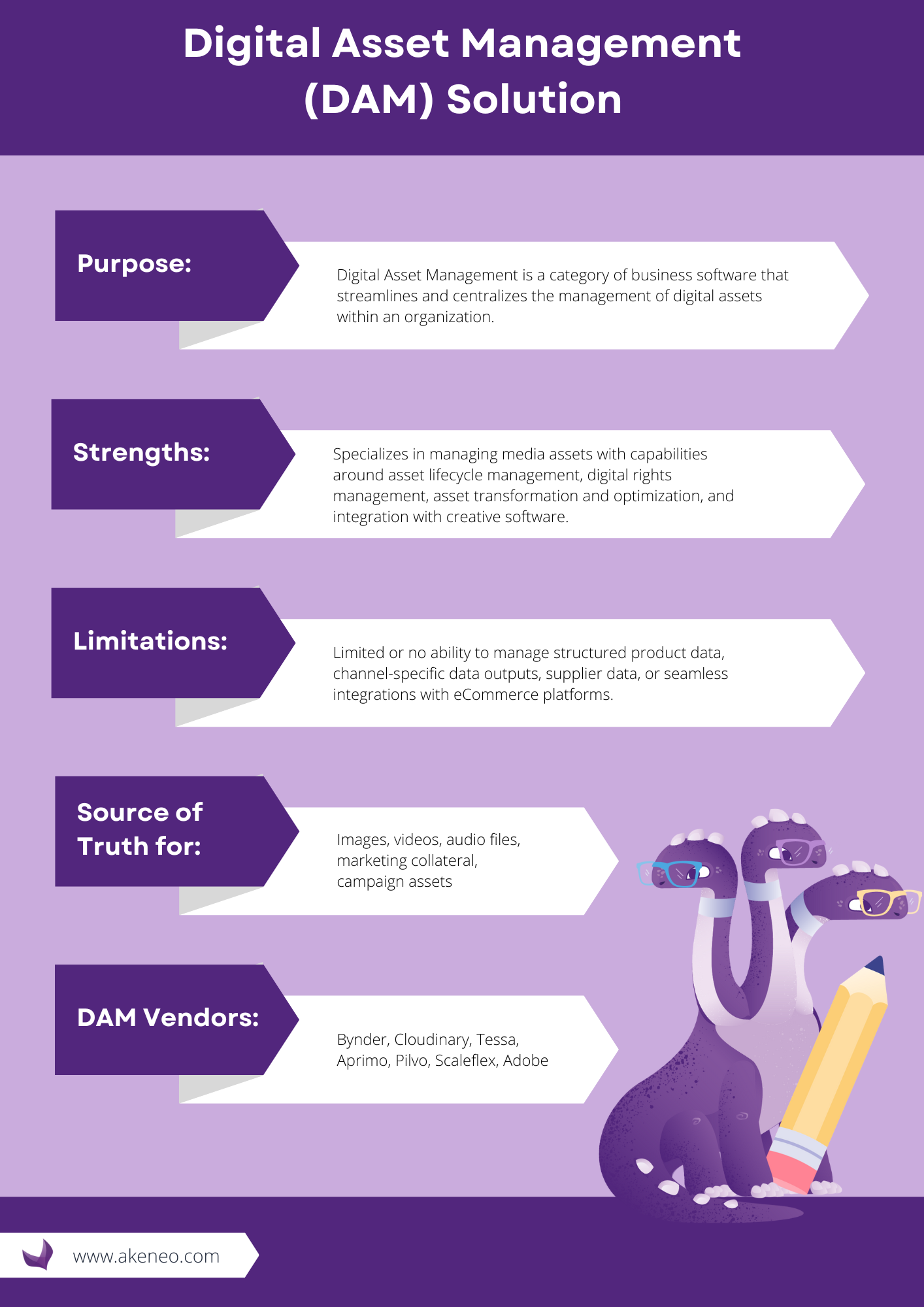Unlock the full potential of your product experience by understanding the critical role that Digital Asset Management (DAM) systems play in enhancing the visual elements of your online presence. Discover how DAM, as the powerhouse for multimedia content, seamlessly integrates with Product Information Management (PIM) solutions, creating a strategic synergy that ensures your organization delivers an unparalleled product experience.

Keywords
People are visual, and this oversight can crush your conversion rate. When shopping online, we want to see engaging and informative images and videos of the products we’re going to buy.
Digital Asset Management solutions (DAM) are the Rolls Royces of media management and what many brands turn to when it comes to handling their media assets. But how exactly do DAM systems fit into the Product Experience ecosystem?
Let's take a look and see how PIM and DAM systems are, in fact, complementary technologies that allow organizations to deliver top-tier experiences for customers by combining rich media assets with compelling product information.
Digital Asset Management (DAM) software solutions are tools designed to efficiently organize, store, retrieve, and manage digital assets within an organization. These assets can include images, videos, documents, and other multimedia files.
DAM systems provide a centralized and searchable repository, enabling teams to easily locate, share, and collaborate on digital content. By streamlining workflows and ensuring version control, DAM software can enhance productivity, brand consistency, and the overall management of an organization's digital resources.
With features like metadata tagging, permissions management, lifecycle management and support for API based integrations, DAM solutions contribute to a more organized and accessible digital ecosystem, supporting businesses in maximizing the value of their digital assets.
DAM systems have an important role to play in the product experience ecosystem. Similar to Product Information Management (PIM) solutions, DAM systems serve as a centralized hub for content management.
However, DAM goes a step further by focusing specifically on multimedia content. This specialization makes DAM a powerful complement to PIM, offering a dedicated repository for managing and distributing high-quality visual and audio assets. This ensures that marketing teams, designers, and other stakeholders can swiftly access and utilize compelling images and videos for product listings, eCommerce platforms, marketing campaigns, and other customer-facing materials.
It’s important to note that DAM systems are intended to manage the entirety of a business’ media content, not just product related assets. This means DAM systems manage media needs for many departments within the organization and store assets for things like corporate communications, legal, human resources, training & development, brand assets and more.
For organizations just looking to store product related assets, a dedicated DAM solution may be overkill in terms of cost and complexity. Many PIM solutions also include the ability to handle product-related media assets, which can be a great alternative if there’s no need for the full power of a dedicated DAM solution.
While PIM and DAM share the overarching goal of centralizing content, they serve distinct purposes within the broader product experience ecosystem. PIM excels in managing complex taxonomies of product data, including technical specifications, marketing copy, and sustainability and compatibility information. It’s designed to adapt this information and ensure consistency and accuracy across the entire customer journey, from how products or sets of products are represented in an ad space, displayed in marketing channels, turned into compelling product and brand stories in owned or third-party sales destinations, or even in customer service interactions.
On the other hand, DAM specializes in the visual aspects of product representation and their efficient storage, editing, organization, and retrieval.

It’s important to note that there are many different ways to integrate PIM and DAM systems within an ecosystem. Generally, when integrating a DAM system to a PIM system, establish a single source of truth for each data field and determine who can access and manipulate what within each system.
In most cases, the DAM system will host the media itself as well as metadata, and serve the images via a CDN. The PIM will allow teams to then combine the product record with media originating from a DAM system.
The PIM can be considered a consumer of information from the DAM. Many modern PIMs manage media links directly from a DAM system without actually storing any physical media files.These links can still be used to generate a preview within the PIM though, allowing merchandising teams to work with a complete product record in a single place.
It’s critical to have a strategy for linking images to products. When a product catalog can have hundreds of thousands of products with millions of images, it’s important that a consistent mapping process is in place. Establishing a naming convention is often a good approach.
The actual mapping of images to products can happen within an integration layer, but many PIM solutions also include a rules engine that can automate this effort with no additional development work needed.
Finally, media transformations and editing (cropping, resizing, recoloring, watermarking etc.) typically occur within the DAM system, which has more robust capabilities in this space.
In conclusion, the combination of Digital Asset Management (DAM) and Product Information Management (PIM) solutions represents a strategic synergy within the product experience ecosystem. While PIM excels in managing comprehensive product data, DAM specializes in the efficient storage, organization, and retrieval of visual assets.
Together, these complementary technologies empower organizations to deliver a unified and seamless combination of rich media assets and comprehensive product information.
Discover how PIM and DAM solutions can work together to provide your customers with the best product experience possible.


Point-of-Sale systems are transforming how businesses operate — from processing payments to tracking data and improving customer service. Discover...
Read more
SAP Hybris is a powerful eCommerce and customer experience platform, but its full potential is often limited by inefficient product data management...
Read more
Product content syndication is transforming the way brands distribute and manage product data across multiple sales channels. By automating updates...
Read more